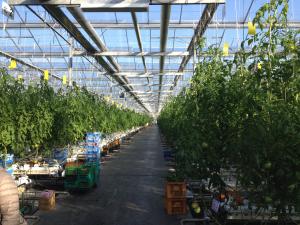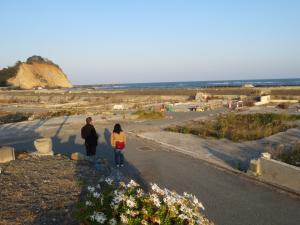Our first port of call was the Agricultural Technology Centre in Koriyama City. Here we were introduced to the way scientists are breeding rice, fruits and vegetables to not only be more resistant to inclement conditions, but also to taste better. We also learned about the methods used to measure the levels of radioactivity in Fukushima produce. I was particularly impressed by the fact that since the disaster, the upper limit of radioactivity at which produce can still be sold has actually been reduced. This really reassured me of the safety of food grown in Fukushima. After lunch, our next stop was at Tomato Land Iwaki. Inside the massive greenhouse, rows and rows of tomatoes are grown as well as a selection of other vegetables. We listened to how the building was damaged during the earthquake and how they've had to work extra hard to reassure consumers of the safety of their tomatoes. Visiting the coast of Fukushima at a place called Hisanohama was a particularly moving experience. Despite having seen the devastation caused by the tsunami first-hand on numerous occasions and in various places, the scale of destruction never ceases to amaze me. In the picture you can see where part of the cliff crumbled away into the ocean as a result of the tsunami. A visit to the Hamakaze Shopping District and dinner near our hotel rounded off a successful day one of the tour. Day two began at an organic cotton farm where we harvested cotton grown in Iwaki and made cute little cotton dolls. Picking the cotton was a relaxing affair, unless you had a fear of spiders, in which case it was almost impossible. They scuttled along the cotton plants and along the ground as you moved along each row. After a delicious seafood lunch, we were taken to a kamaboko factory. We listened to the young, enthusiastic PR manager as he taught us about market economics and how they are recovering after the stigma around Fukushima produce and in particular Iwaki seafood. We were fortunate enough to be able to sample some of their kamaboko. I particularly enjoyed the new styles of kamaboko they have developed, although it was clear these were not to most other people’s tastes. Our last stop was the beautiful Shiramizu Amidado Temple. The stunning autumnal colours still lingered in the trees and their reflections shimmered in the tranquil waters. After a quick photo shoot it was back on the bus and time to head home after a most enjoyable and interesting weekend. |  |

| Summary |








